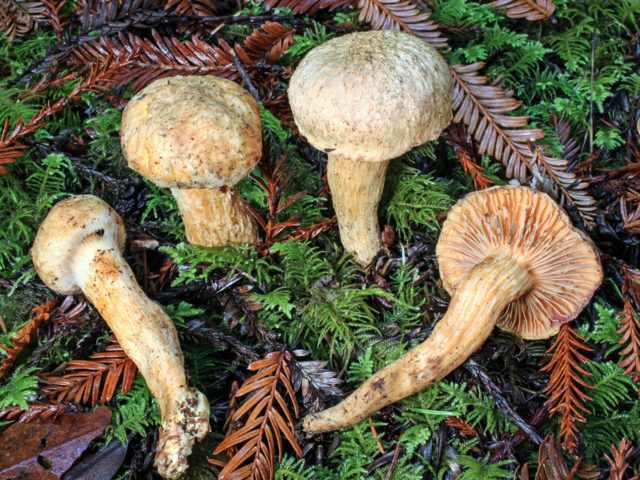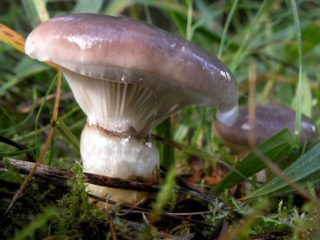Content
Tomentose fungus is a type of lamellar mushroom that belongs to the genus Chroogamphus. The fruit body is edible and does not pose a health hazard after heat treatment. Grows in coniferous forests. It is quite rare and is protected by the state.
What do felt moths look like?
The hat has a convex shape. Its surface is whitish and feels like felt. The color is brown or ocher. The cap is smooth along the edges and consists of depressed areas. At the bottom there are plates that go down to the leg. Their color is brown with an orange tint.
The upper part ranges in size from 2 to 10 cm. Often there is a tubercle protruding in the middle. Along the edges there are remains of the bedspread. The surface is dry and becomes sticky after rains.In warm weather the cap is fibrous and felt-like. Various colors: yellow, brown, pinkish. Sometimes the burgundy fibers are clearly visible.
The pulp of the felt mokruka is dense, ocher, with pronounced fibers. It dries quickly and acquires a pinkish tint. The leg is smooth, swollen in the central part. The coloring of the fruiting body is uniform. The blanket is fibrous, reminiscent of a cobweb.
Where do felt moths grow?
The felt fly prefers forested areas. It is often found in mixed and coniferous forests. The fungus forms mycosis on pine, cedar and black fir. Fruiting bodies grow singly or in large groups. Favorable conditions for the species are high humidity and warm weather.
The distribution area includes the Far East: Primorsky Krai and the Sakhalin region. Also grows in Japan and North America. The fruiting period is in autumn. Mokrukha appears from September to October.
The extinction of the species is associated with deforestation and fires. As a result, the source of food for fungi, the wood of coniferous trees, is lost. Therefore, today special attention is paid to the preservation of forests in the Far East.
Is it possible to eat felted moths?
Mokruha tomentosa is a high-quality edible mushroom. It belongs to the 4th category of nutritional value. This includes varieties that can be eaten. However, the taste is low. The fruit body does not have a spicy taste or aroma. The pulp does not contain harmful substances that give a bitter taste or pose a health hazard.
False doubles
Felt moth has false doubles. These are mushrooms that are similar in appearance. However, not all of them are edible; there are also less useful specimens. Twins can be distinguished by their characteristic features.
Common false doubles:
- Siberian mokruha. A very close variety, distinguished by a grayish tint to the cap. Very rare. Nutritional properties have not been studied, so it is recommended to avoid consumption.
- Spruce damp. The double has a gray-brown cap with a purple undertone. The shape is convex, gradually becoming flat. In young representatives the cap is covered with mucus. The variety is edible, but its nutritional quality is low.
- Swiss wetweed. Outwardly it resembles a felt variety, but does not have whitish pubescence. The cap is convex, ocher, with smooth edges. The species is considered conditionally edible; it is eaten after heat treatment.
Collection rules
Felt weed is collected in the fall, after the rains. They check clearings and other open areas, places near streams and ponds. First of all, the roots of coniferous trees are examined. The fruiting bodies are carefully cut off with a knife to preserve the mycelium.
Large baskets are used to collect mushrooms. Do not pack the mass too tightly so that it does not heat up. There should be air gaps between individual specimens. After harvesting, it is recommended to process the mushrooms as soon as possible.
Use
The collected mushrooms are placed in clean water for 3-4 hours.Then dirt, leaves, needles and other debris are removed from the fruiting bodies. They are then cut into pieces and simmered over low heat for 45 minutes. The resulting mass is fried, canned, and added to soups, side dishes, and baking fillings.
Conclusion
Mokruha tomentosa is a rare mushroom included in the Red Book of Russia. He is found next to coniferous trees. The variety has several counterparts, among which there are poisonous representatives. The fruiting bodies are eaten after preliminary processing.












